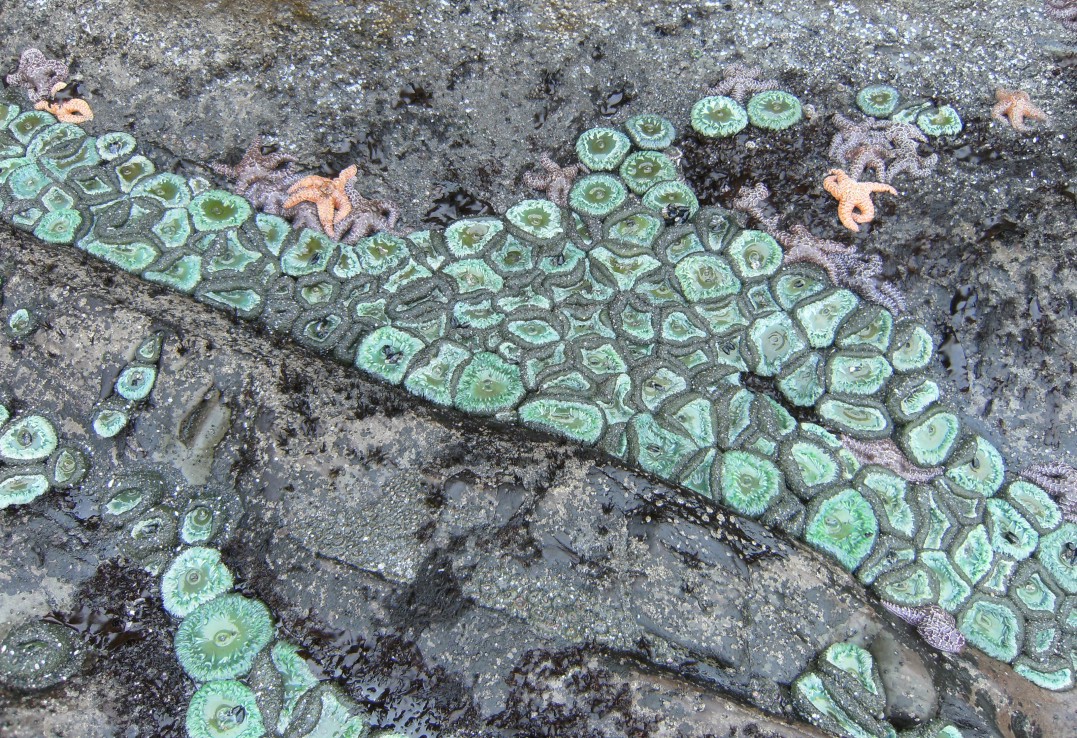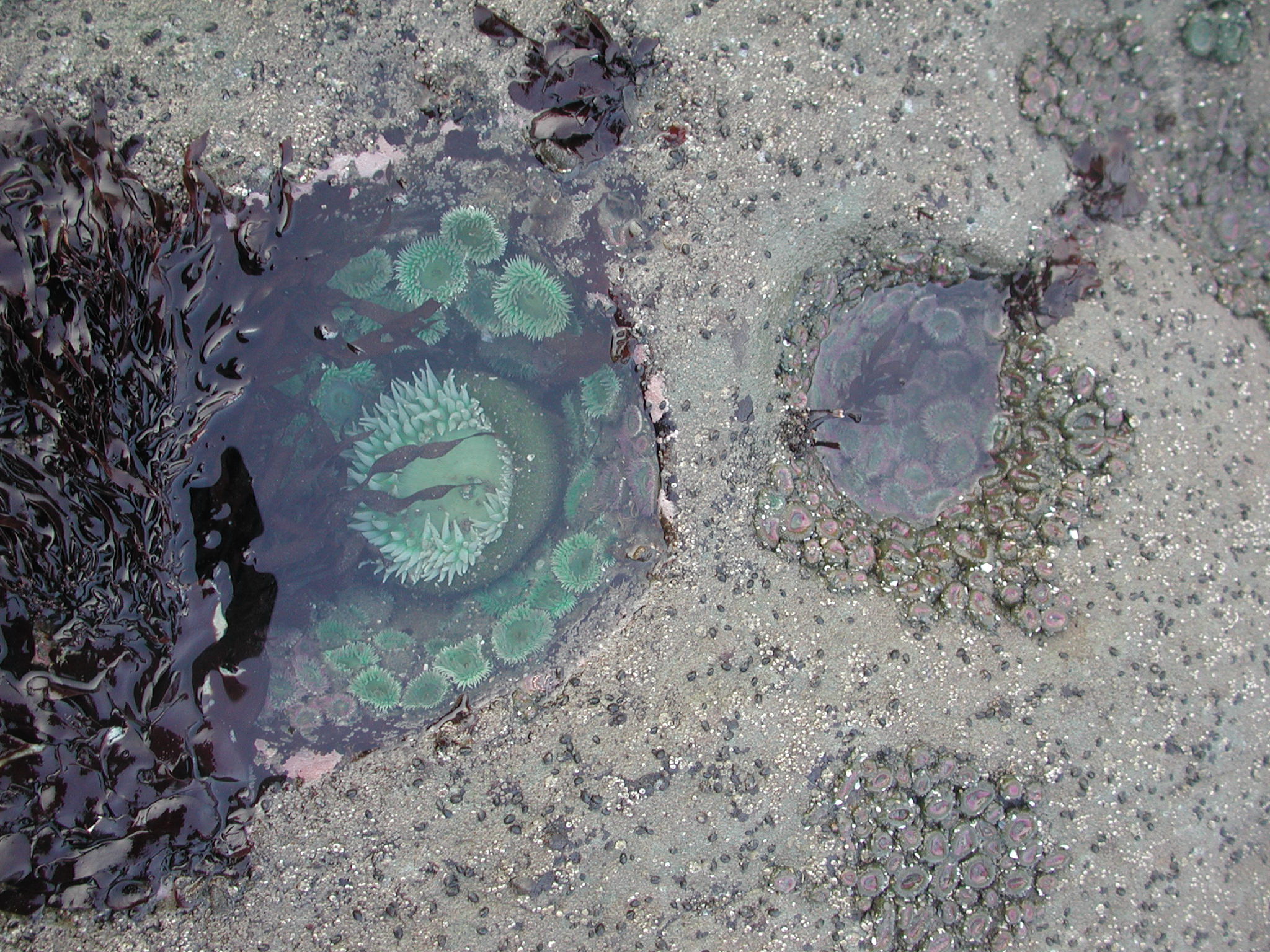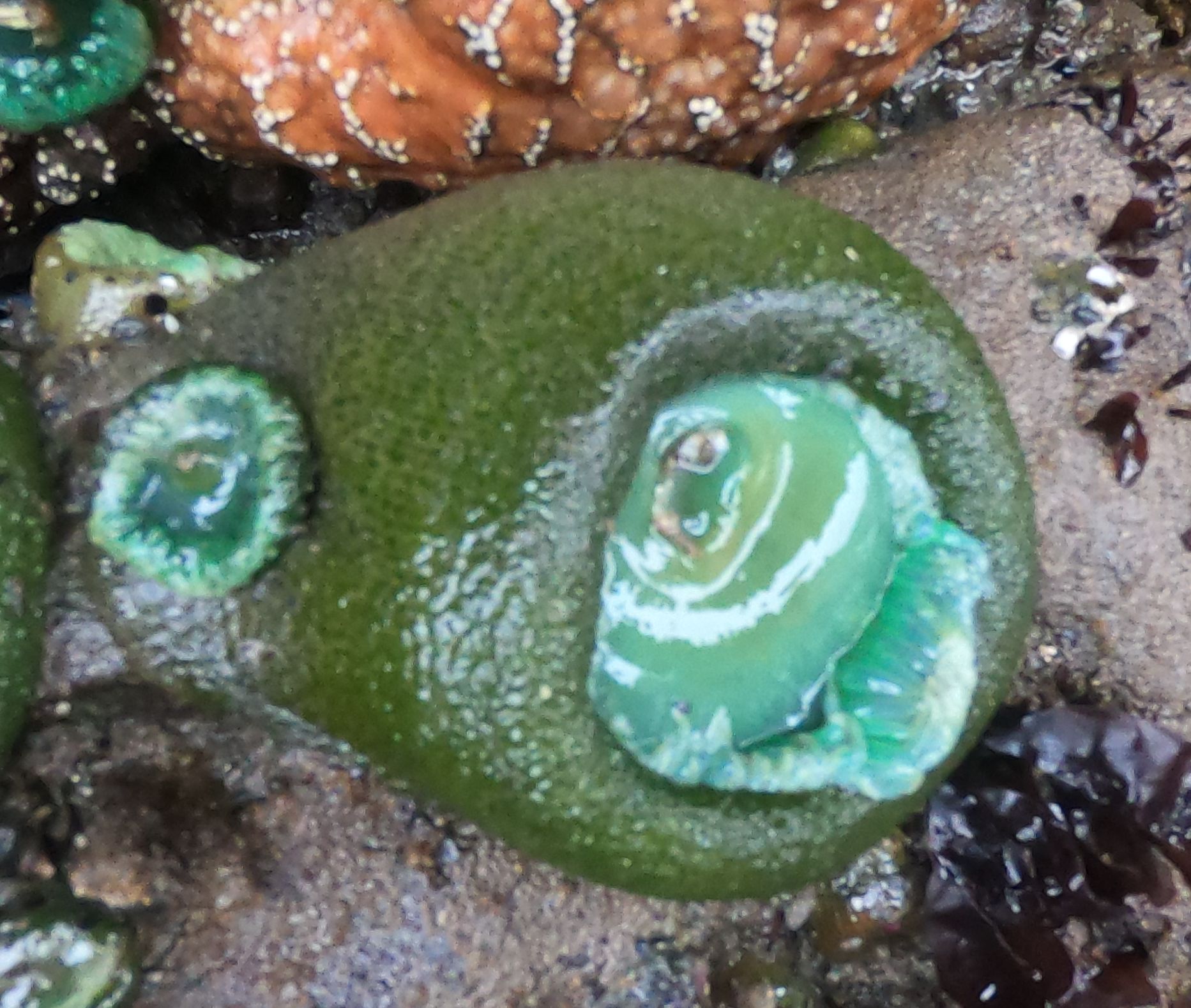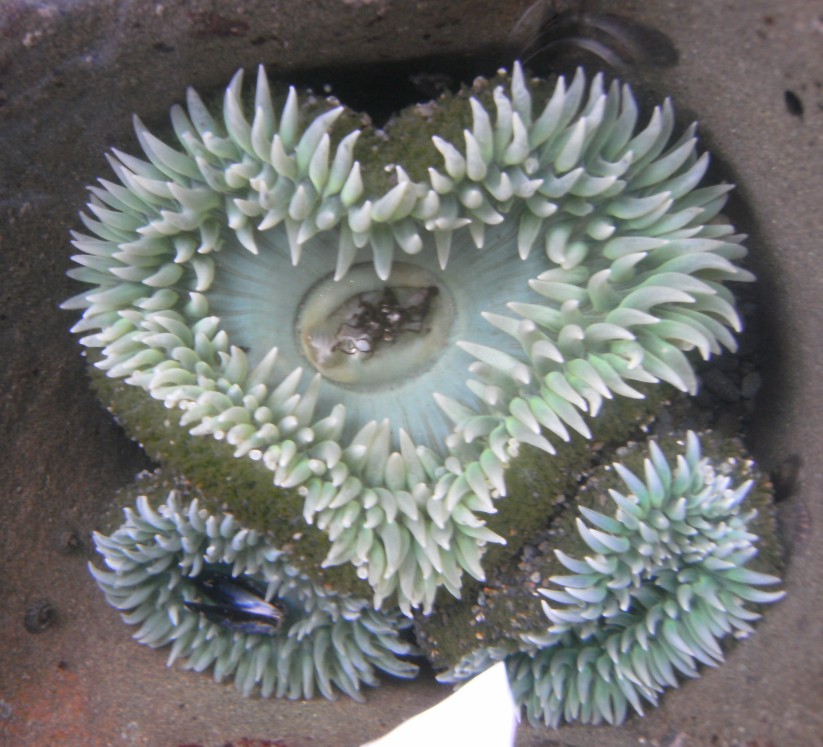Anthopleura xanthogrammica, Brandt (1835)Common name(s) Giant green anemone, green surf anemone, solitary green anemone |
|
| Synonyms: Cribrina xanthogrammica | 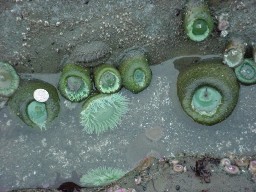
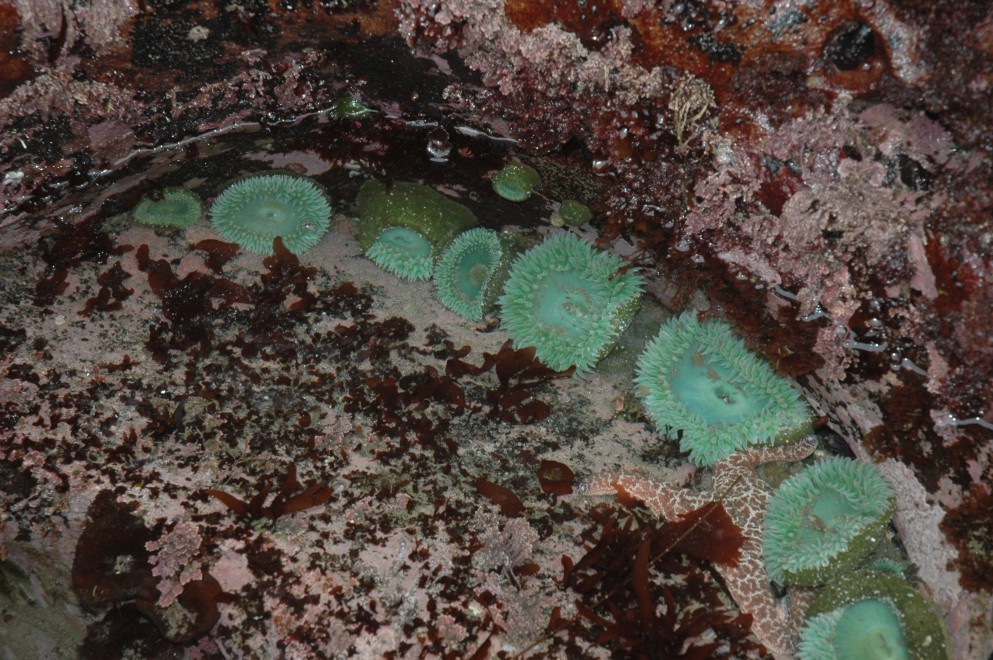 |
| Phylum Cnidaria
Class Anthozoa Subclass Zoantharia Order Actiniaria Family Actiniidae |
|
| Photos of Anthopleura xanthogrammica on rocks, Beach 4, Olympic Peninsula, WA | |
| Top Photo by Brandon White, July 2002. Bottom Photo by Dave Cowles, July 2006 | |
How to Distinguish from Similar Species: May be confused with A. sola or large A. elegantissima but both of those species have pink tips on tentacles, the oral disk is usually striped, and at least some of the tubercles (verrucae) on the column are usually in distinct lengthwise rows up and down the column (picture in A. sola). Anthopleura artemisia has verrucae on only the top 2/3 of its column and usually lives mostly buried in sand.
Geographical Range: From Alaska to Panama, these anemones flourish in the intertidal and subtidal zones. Only found in a few places with upwelling south of central CA.
Depth Range: Benthic to low and mid intertidal zone, also may be found to 30 m depth.
Habitat: Giant green anemones live on the rocks of tide pools and in deep surge channels on exposed rocky shores. They can also be found on concrete pilings in open bays and harbors. Especially common near mussel beds.
Biology/Natural History: A. xanthogrammica is basically a solitary species and can occur in numbers up to 14 per square meter if conditions are favorable. They are vividly green if they are exposed to bright sunlight. The bright green can be attributed to green pigment in the anemone epidermis and to symbiotic algae that live in the tissues that line the gut. Inside there may be zoochorellae (green algae) or zooxanthellae, which are dinoflagellates. The symbiotic algae are reduced in numbers or even absent (aposymbiotic) when in shady areas. The anemones release sperm and eggs in late spring to summer. The larvae swim or float freely, dispersing. The adults do not split in half asexually, as is so characteristic of its congener A. elegantissima. They eat detached mussels, sea urchins, small fish, and crabs. I have also commonly seen them spitting out empty barnacle plates so I suspect they will eat barnacles as well. Mussels seem to be a primary item in the diet. Guy et al report consumption of dislodged seabird chicks by anemones located below cliff-nesting seabirds such as cormorants and gulls. Predators include the seastar Dermasterias imbricata. The sea spider Pycnogonum stearnsi is often found around the base in central California and the large amoeba Trichamoeba schaefferi may be found as well. In southern California the snail Opalia borealis, which feeds by inserting its proboscis into the column, may be on the base and the wentletrap snail Epitonium tinctum may also be found. Epitonium tinctum feeds on the anemone's tentacles at high tide.
Cnidae in this species include Spirocysts, atrichs, basitrichs, and microbasic p-mastigophores.
This is one of the largest species of anemone in the world. Some Antarctic species, our local, subtidal Metridium farcimen, and tropical anemones on coral reefs grow larger. It does not survive well in areas with sewage or other pollution.
| Return to: | |||
| Main Page | Alphabetic Index | Systematic Index | Glossary |
References:
Dichotomous Keys:
Carlton, 2007
Kozloff, Eugene, 1987, 1996.
General References:
Harbo,
1999
Kozloff,
1993
Lamb
and Hanby, 2005
Morris
et al. 1980. Intertidal Invertebrates of
California. Stanford
University Press.
Ricketts
et al., 1985
Scientific
Articles:
Cowles, David L., 1981. The percent contribution
of fixed
carbon by symbiotic algae to the daily respiratory carbon needs of the
sea anemone Anthopleura xanthogrammica
(Cnidaria; Anthozoa).
Master's Thesis, Walla Walla College.
Guy, Lisa Sheffield, Lisa Bullis Habecker, and Gretel Oxwang, 2014. Giant green anemones consume seabird nestlings on the Oregon coast. Marine Ornithology 42 pp 1-2
Hand, Cadet, 1955. The sea anemones of central California part II. The endomyarian and mesomyarian anemones. The Wasmann Journal of Biology 13:1 pp. 37-99
Secord, D. L., and L. Augustine, 2000. Biogeography and microhabitat variation in temperate algal-invertebrate symbioses: Zooxanthellae and zoochlorellae in two Pacific intertidal sea anemones, Anthopleura elegantissima and A. xanthogrammica. Invertebrate Biology 119: 139-146
Sebens, K.P., 1977. Habitat
suitability,
reproductive ecology
and the plasticity of body size in two sea anemone
populations. Ph.D.
Dissertation, University of Washington.
General Notes and Observations: Locations, abundances, unusual behaviors, etc.:
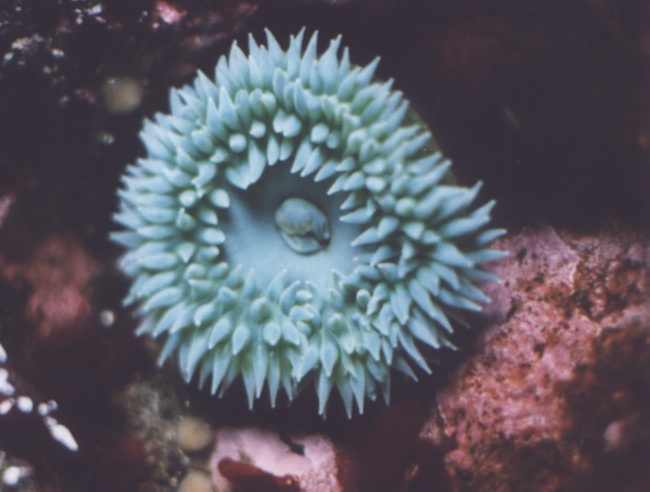
This photo of A. xanthogrammica was taken by Dave
Cowles at
Cape Flattery, 1997
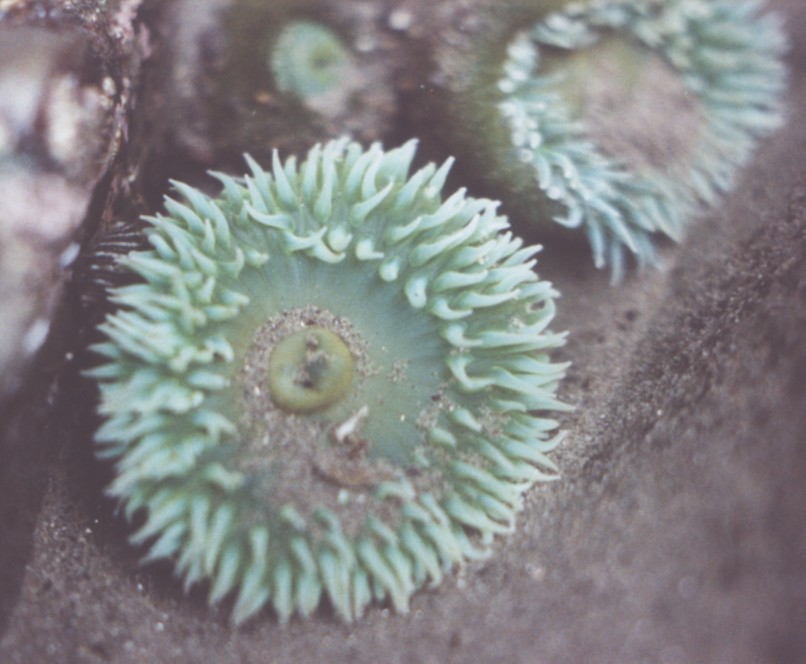
This specimen is from Hole in the Wall, Rialto beach. Photo
by
Dave Cowles, July 1995
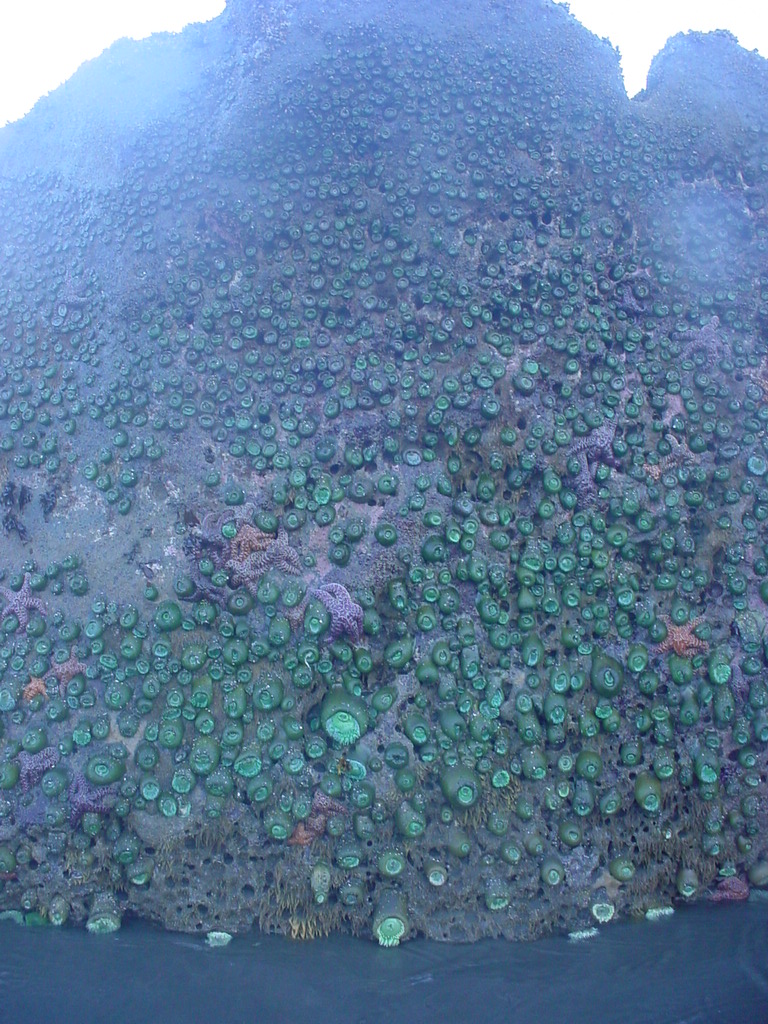
These A. xanthogrammica are covering the vertical,
landward
face of a rock in the surf zone of Beach #4, Olympic Peninsula.
Note that though there are many anemones on the rock, they avoid
becoming
close-packed as seen in A.
elegantissima clones.
The largest anemone here is about 15 cm diameter. This is an
unusual location-they are more commonly found in the lower subtidal
pools and crevices below mussel beds. Photo by
Dave
Cowles, July 2005
When living space gets crowded and the food source gets concentrated, however, they are capable of crowding quite close together. This photo is of anemones crowding a bedrock depression below a vertical rock surface populated by barnacles at Beach #4, Kalaloch, WA. Some sources say they can be at a density of up to 14 anemones per square meter, but the total space in this crevice is probably not much more than 1 square meter and there are far more than 14 anemones there. Nevertheless, they have left at least a little space between them as shown by the fact that the seastar can crawl between them. They probably appear more close-packed in this photo than they would while underwater because they have collapsed at low tide. Photo by Dave Cowles July 2012
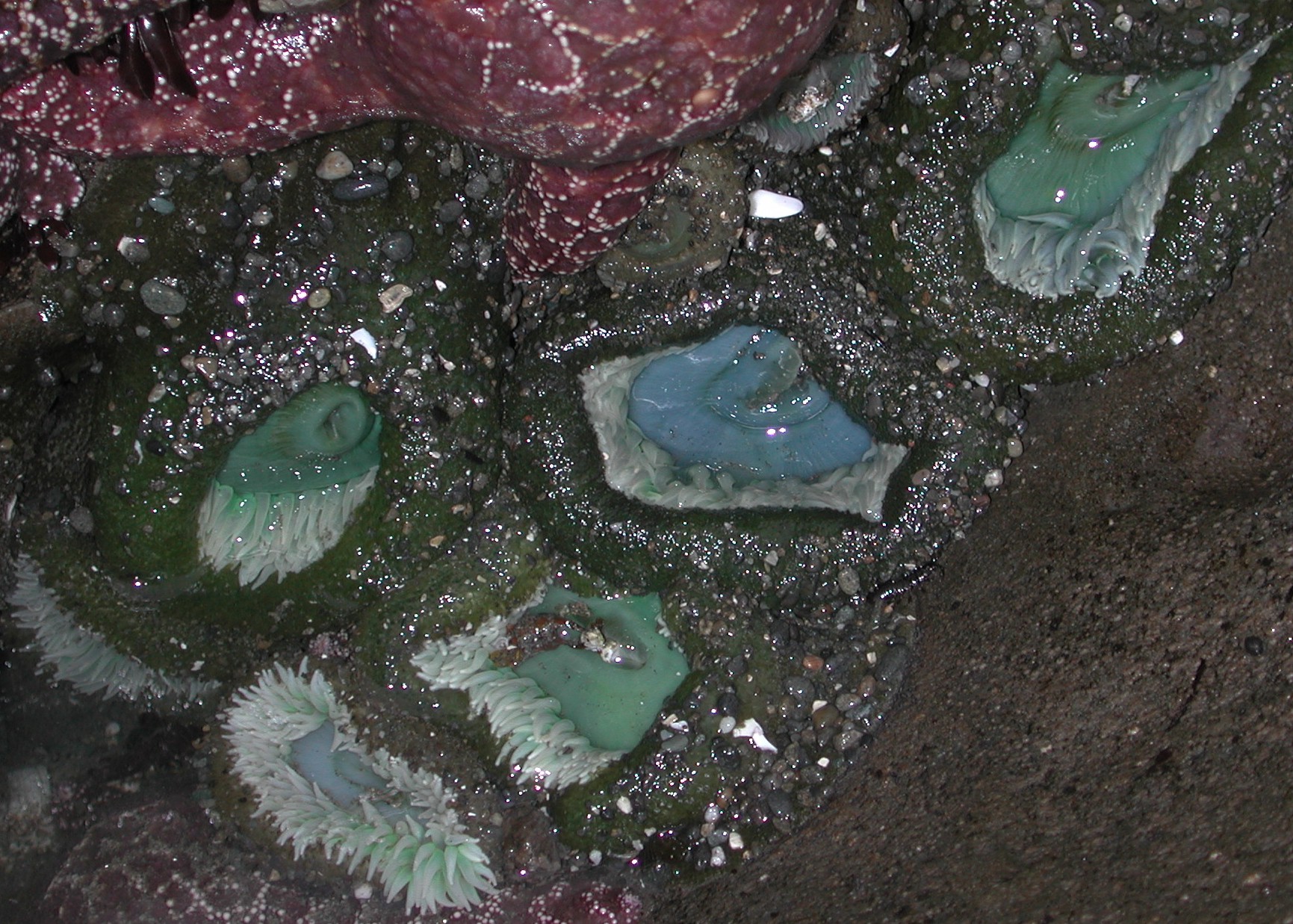
Some individuals, such as these at Beach #4 near Kalaloch, have a
strong
blue color on the oral disk.
Photo by Dave Cowles, July 2008
This individual, photographed at Beach #4 near Kalaloch, has unusually pronounced stripes on the oral disk. Strong stripes on the oral disk such as this are more characteristic of Anthopleura sola. Photo by Dave Cowles, July 2009
Diet of Anthopleura xanthogrammica:This species eats a variety of large prey, but especially the mussel Mytilus californiensis. The position in which the anemones are found: on the outer coast, lower rocky intertidal, in crevices and tidepools below mussel beds, provides an ideal location for capturing mussels dislodged from the rocks above. They are opportunistic, and will eat other prey if they encounter them, however. |
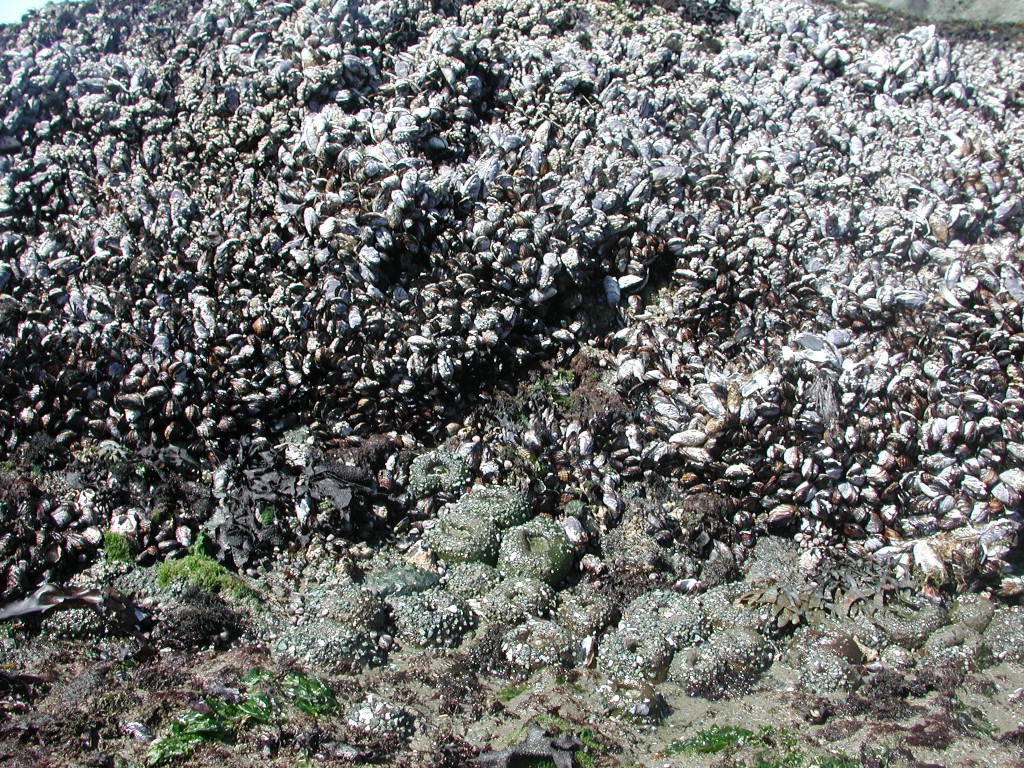 |
|
These Anthopleura xanthogrammica are clustered at a
low point
below a bed of Mytilus
californianus mussels, their favorite food.
Photo on Shi Shi Beach by Dave Cowles, August 2007 |
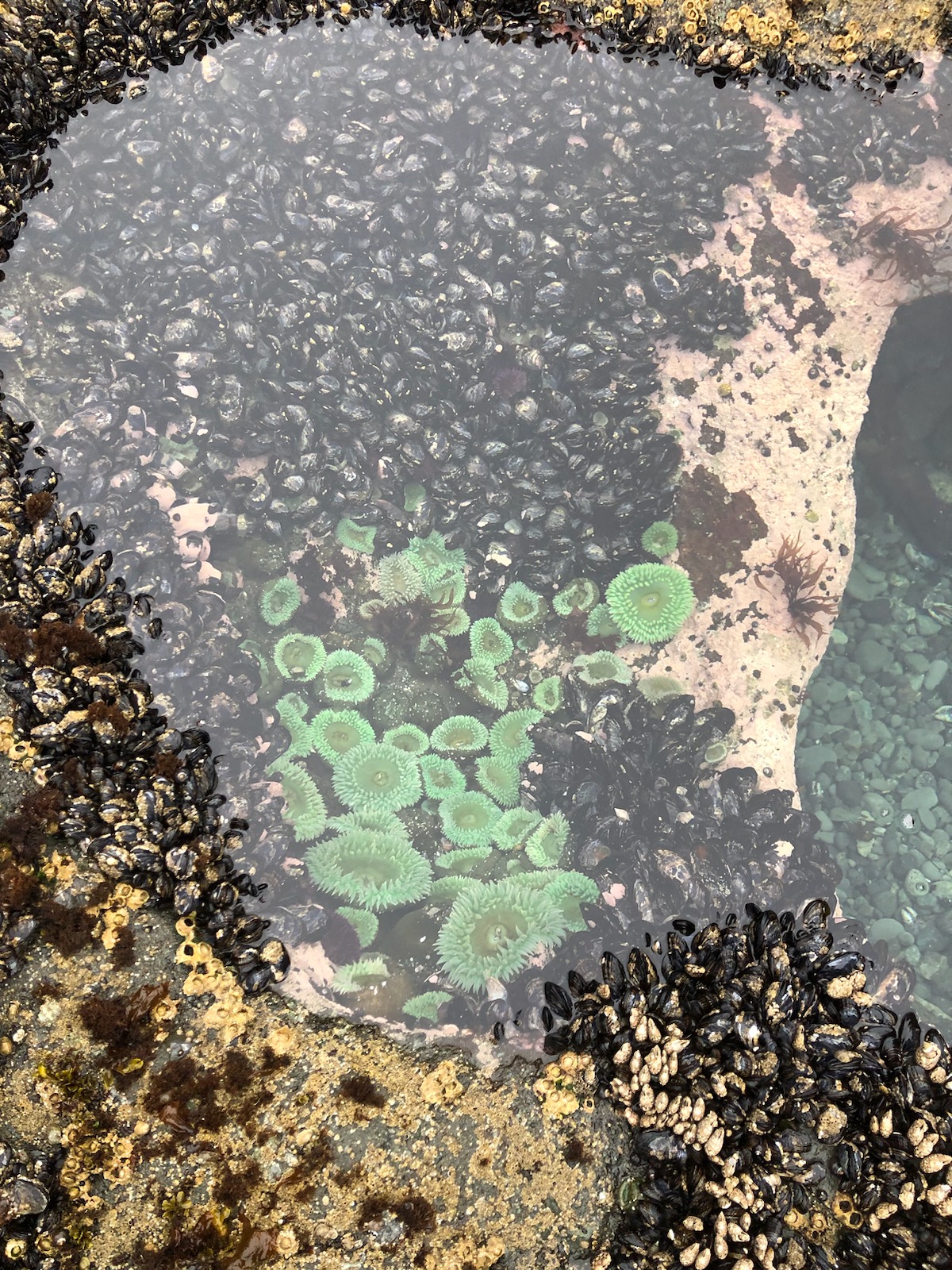 |
| In this view of the invertebrate connumity in an intertidal kettle pool on Shi Shi beach, a cluster of Anthopleura xanthogrammica anemones is heavily surrounded by their favorite meal: Mytilus californianus mussels. Photo by Dave Cowles, July 2023 |
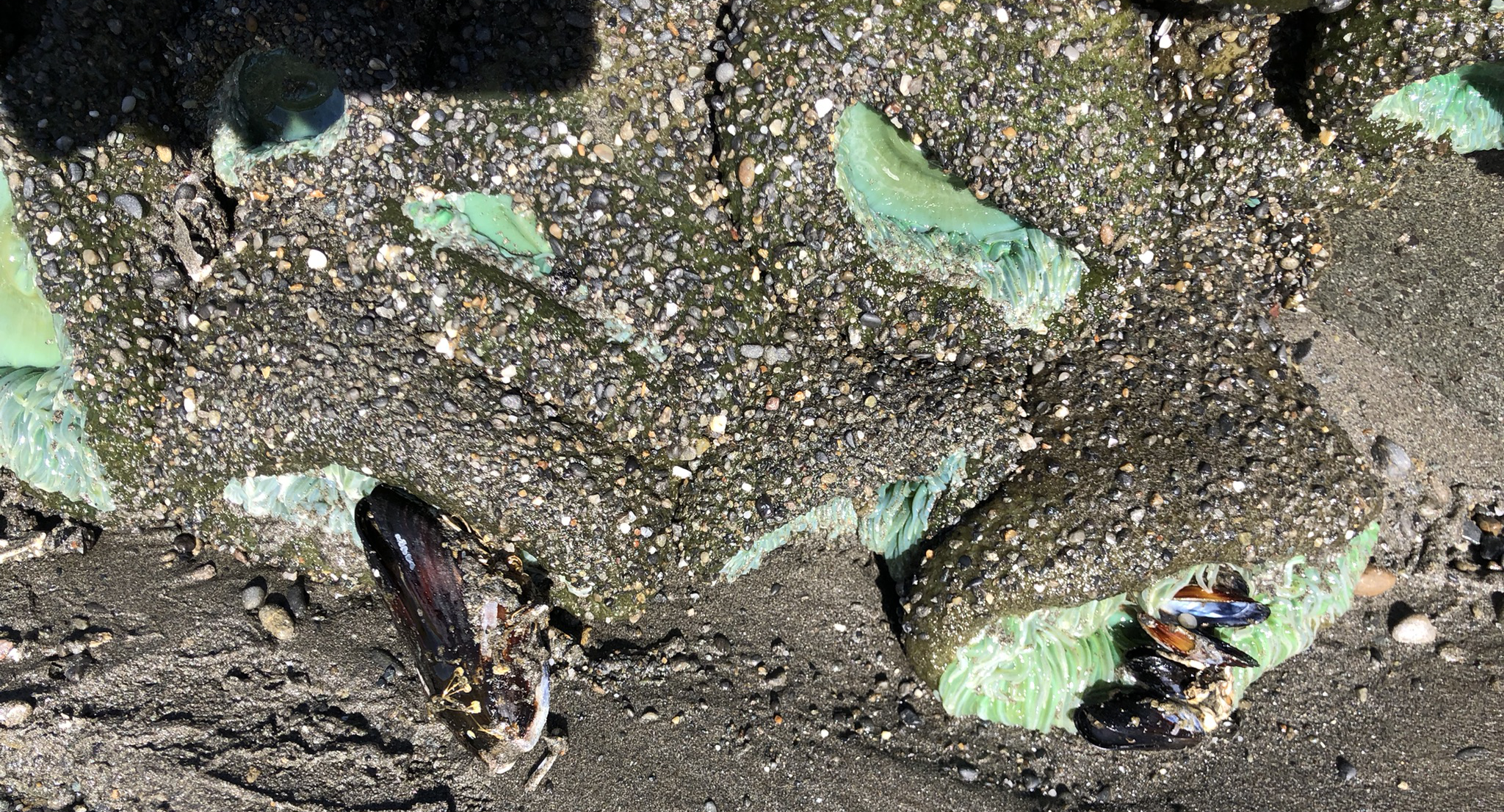 |
| These individuals at low tide at Kalaloch Beach #4 have just finished their favorite meal: mussels! Since anemones, like all Cnidarians, have a "blind gut" they must expel any indigestible parts out their mouth opening as these are doing with the shells. Photo by Dave Cowles, July 2024. |
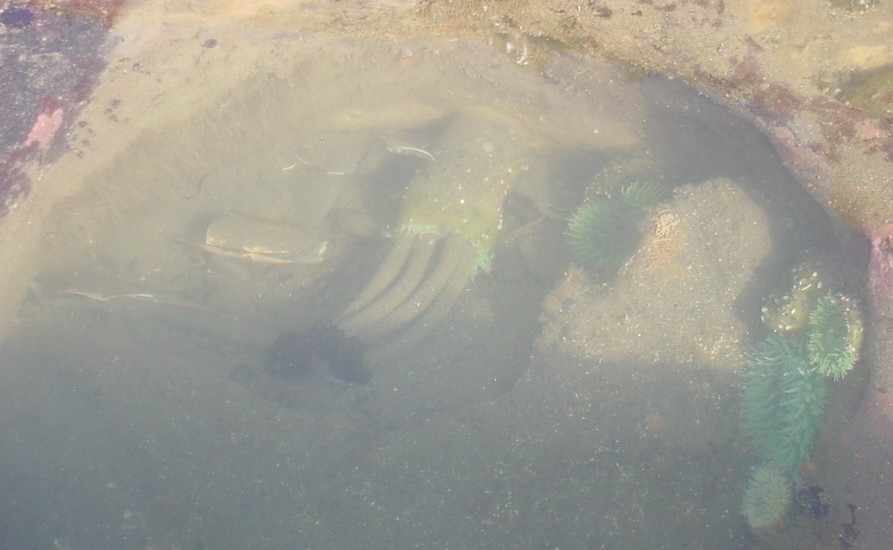 |
| One Anthopleura xanthogrammica in this tidepool has partly swallowed four Eudistylia vancouveri Polychaete tubeworm tubes. The worms are still alive and well. I have seen them feeding on this species, still within the tubes, multiple times. It is not clear whether they can actually digest the worm and get any nutrition from it while it is in the tube, or whether they will eventually just spit the tube out. The discoloration in the water may be from recent heavy wave action, an algal bloom, or could be from sperm this anemone species sometimes sheds into the water during summer season. Photo from Olympic Peninsula Beach #4 by Dave Cowles, July 2005 |
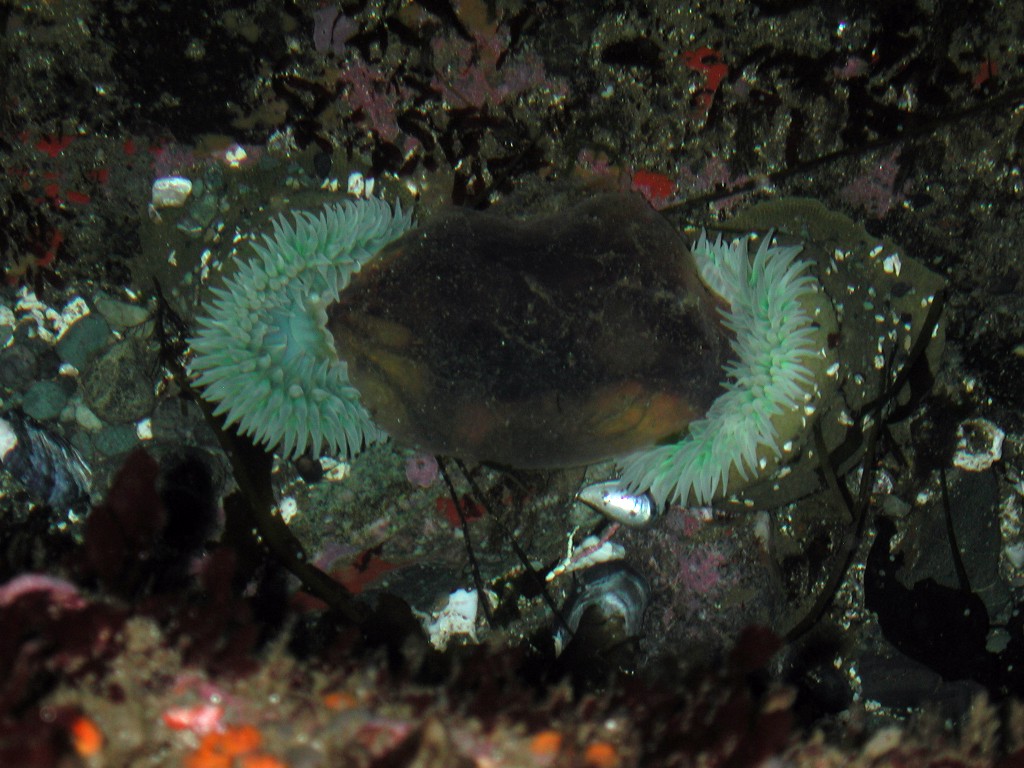 |
| These two individuals in a sea cave tidepool on Cape Flattery were eating a lion's mane jellyfish, Cyanea capillata. Photo by Dave Cowles, July 2008 |
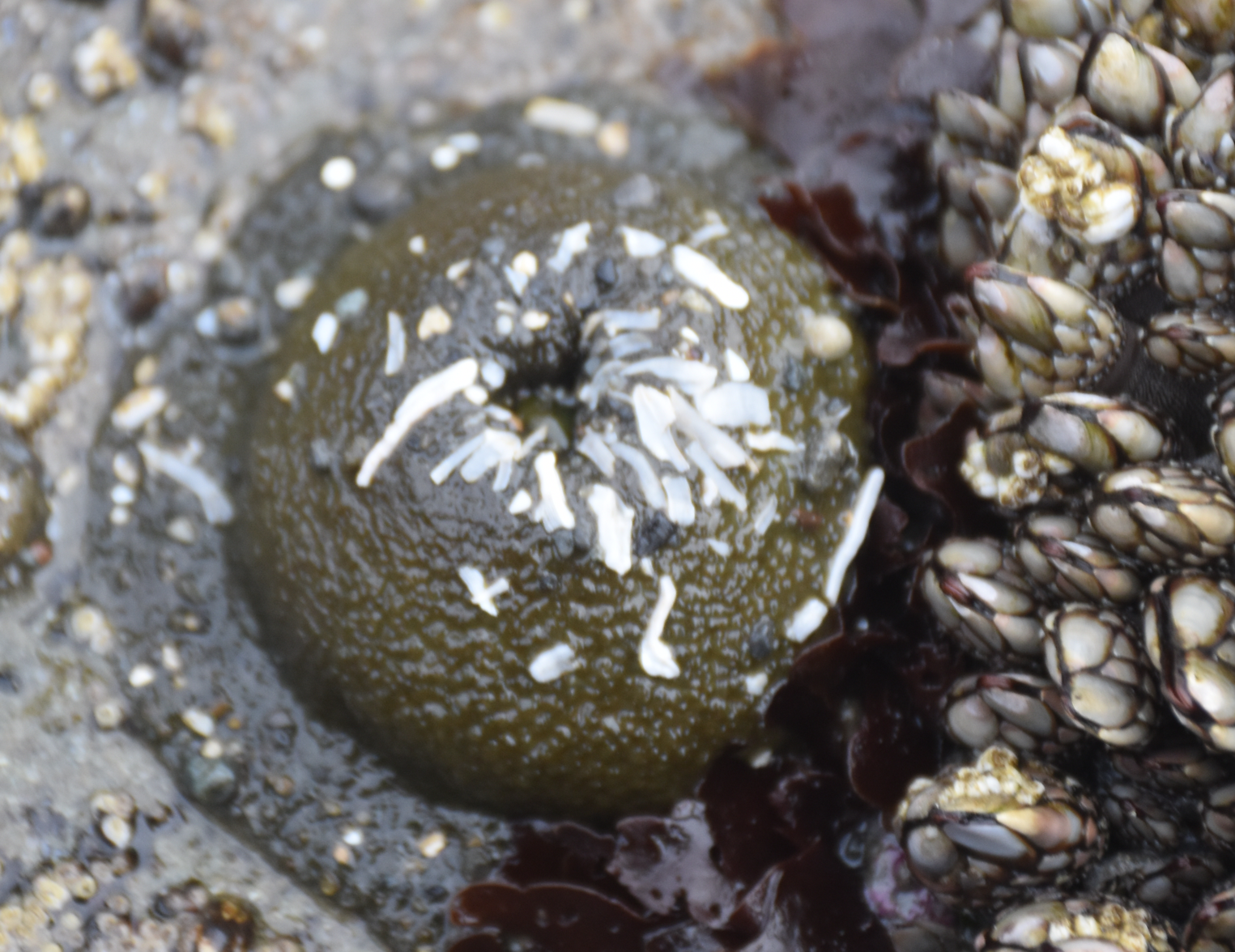 |
| The gut (gastrovascular cavity) of Cnidarians such as anemones is a blind gut, meaning that there is only one opening so anything that goes in the mouth but cannot be digested must be spit back out again. This Anthopleura xanthogrammica has spit out the undigestible wall plates of a barnacle it has eaten. Photo by Dave Cowles, July 2021 |
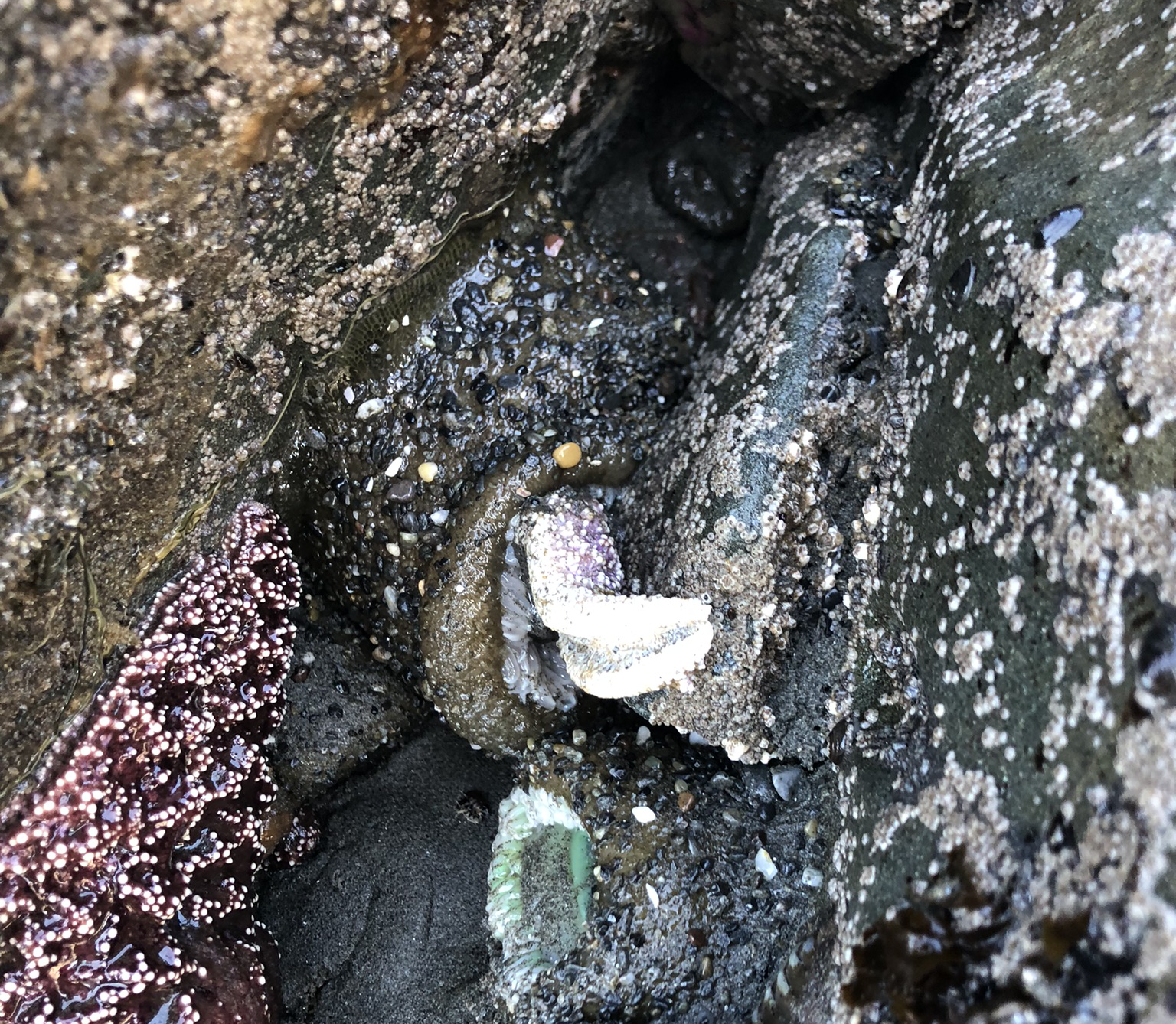 |
| The individual above is eating a ray (arm) from the seastar Pisaster ochraceus, probably one that was autotomized (released) by the seastar that originally owned it. Another, whole Pisaster ochraceus is to the left. The individual below has just finished a dinner of barnacles, and is spitting out the indigestible plates. Photos by Dave Cowles, July 2024. |
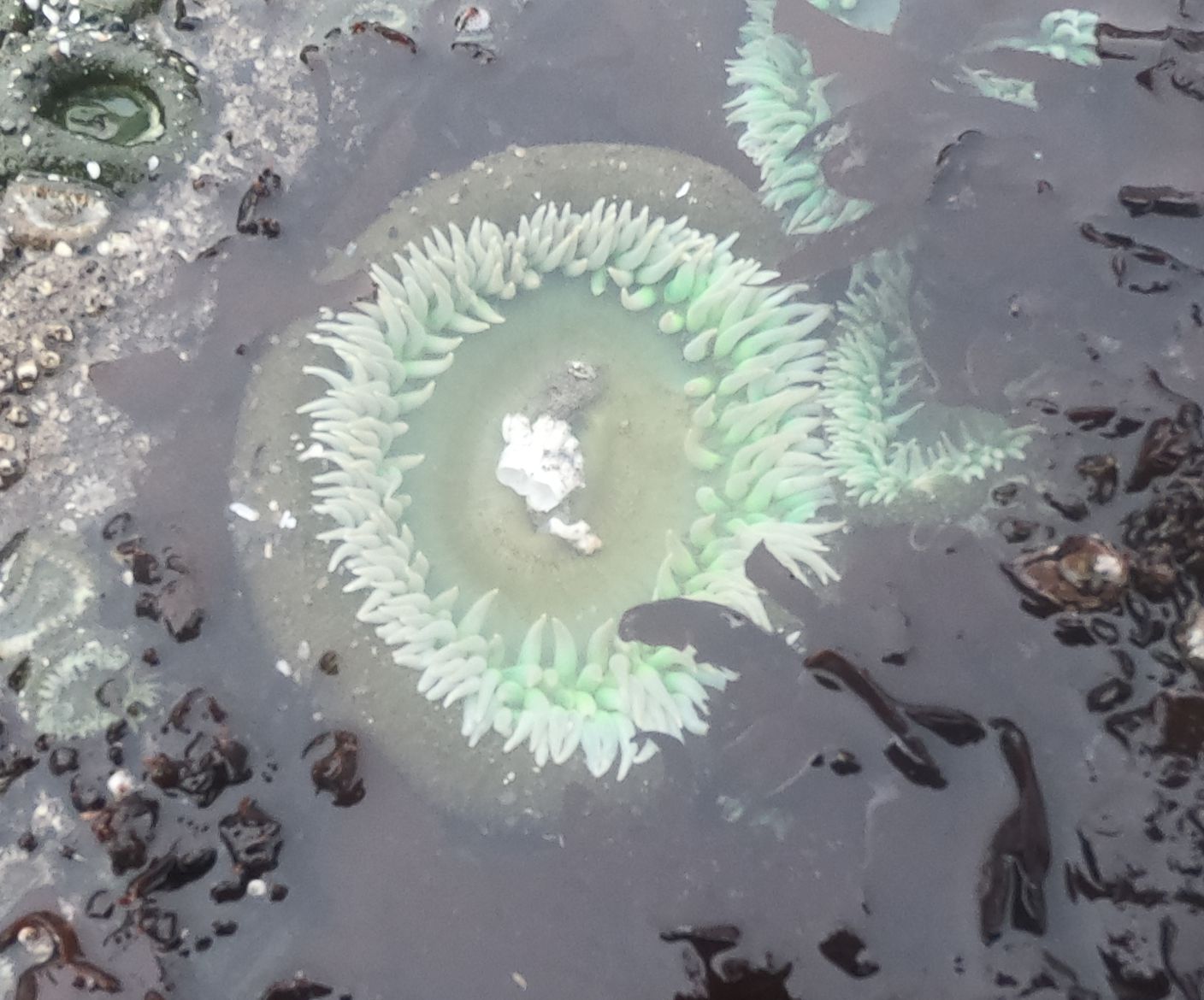 |
| The anemone below has just finished eating (or rejecting) um.....who knows what? Photo by Dave Cowles, July 2025 |
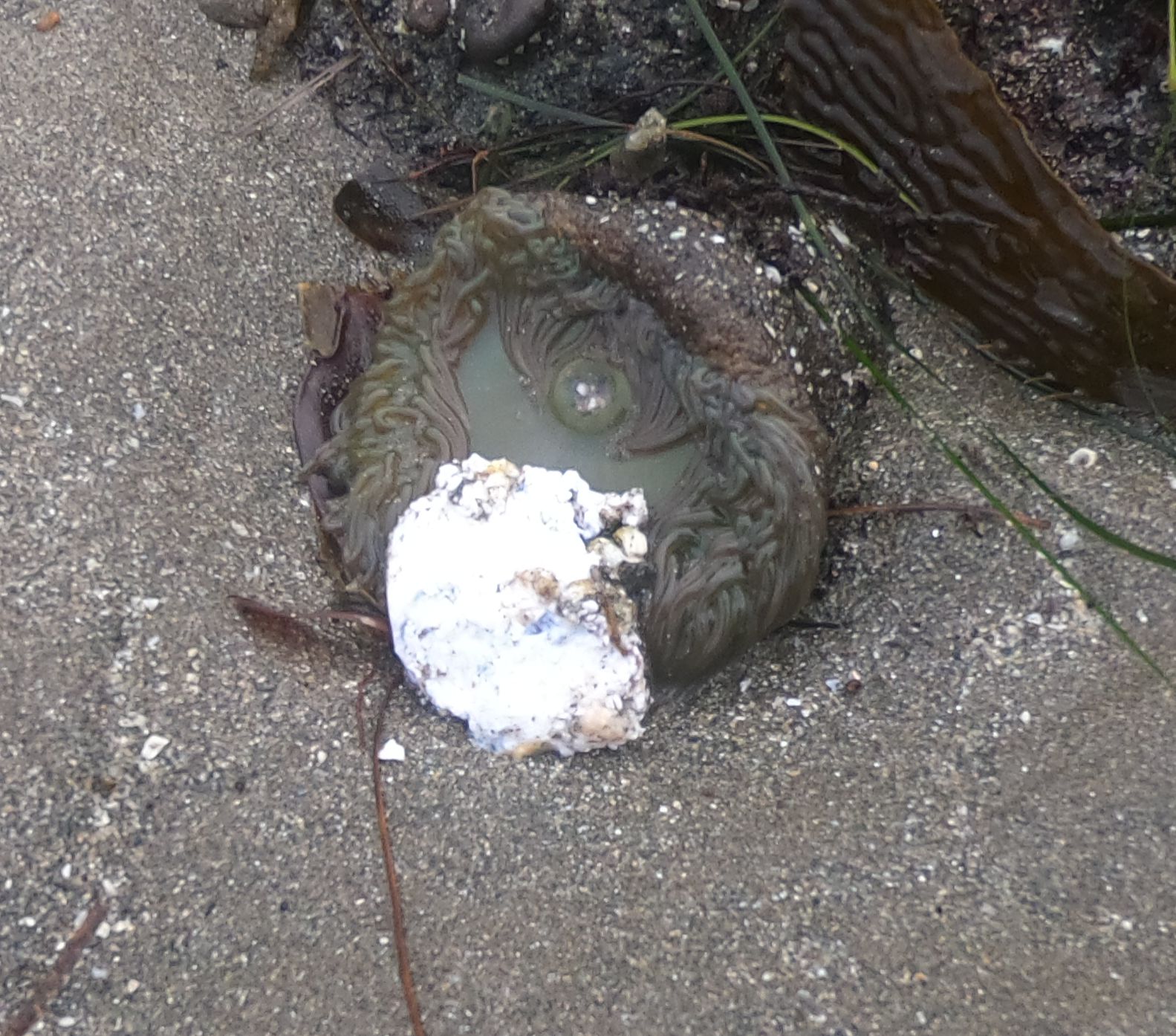 |
| On this crowded intertidal rock wall below, several mussels have gotten pushed right down among the anemones just waiting for the chance to get at them. So far they have escaped predation but I presume that sometime soon they may end up as dinner for one of their close anemone neighbors. Photo by Dave Cowles July 2025. |
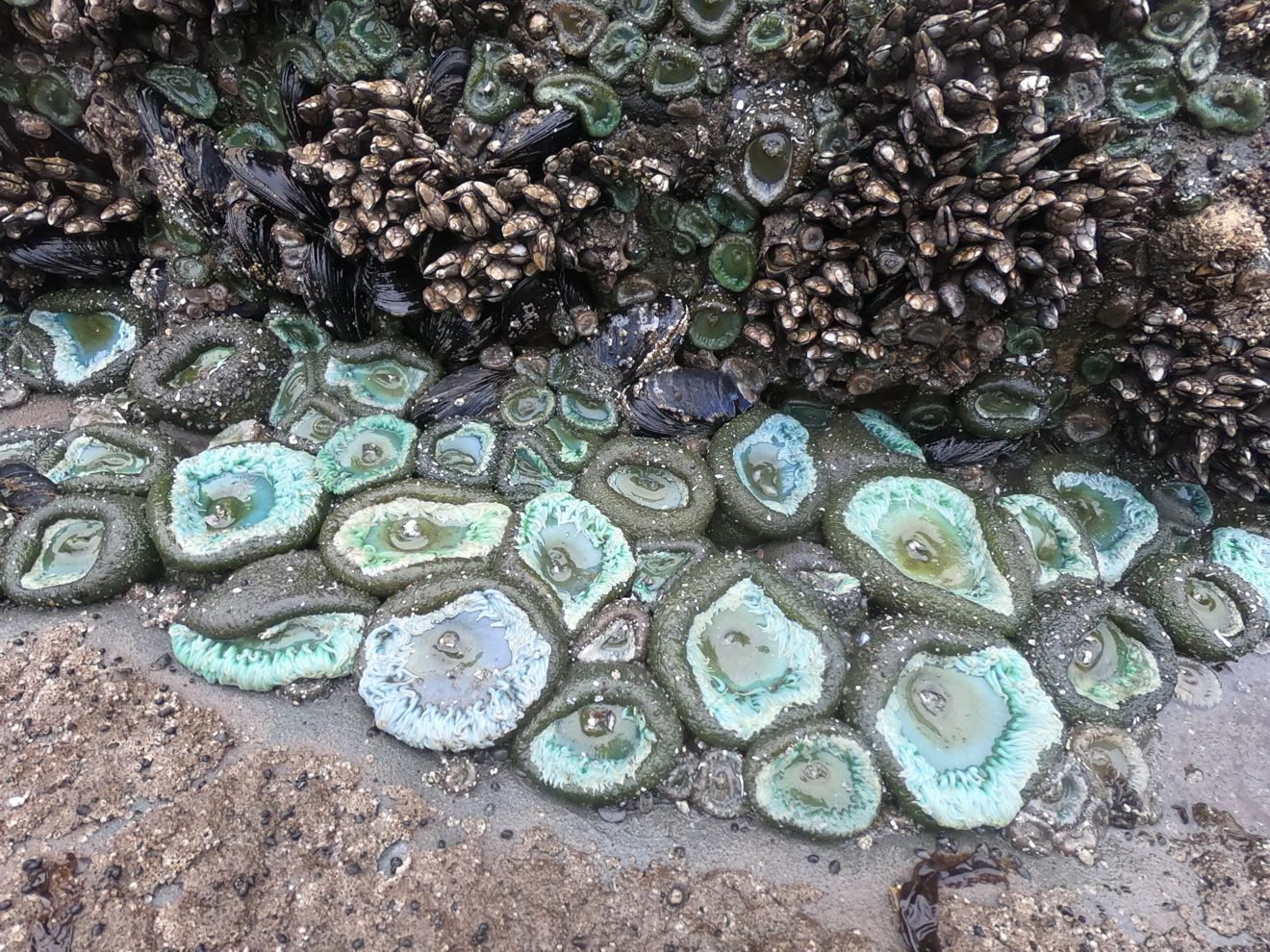 |
Anthopleura xanthogrammica and A. elegantissima can often be found side by side on the open coast. In this photo, A xanthogrammica and a few individuals of A. elegantissima are in the pool to the left, while A. elegantissima fills the pools to the right. Note that A. xanthogrammica grows larger, is greener, and does not have pink tips on its tentacles. Also, though A. xanthogrammica individuals can occur in close proximity to each other, they usually maintain a bit more personal space around themselves than do the close-packed A. elegantissima. Photo by Dave Cowles, July 2009
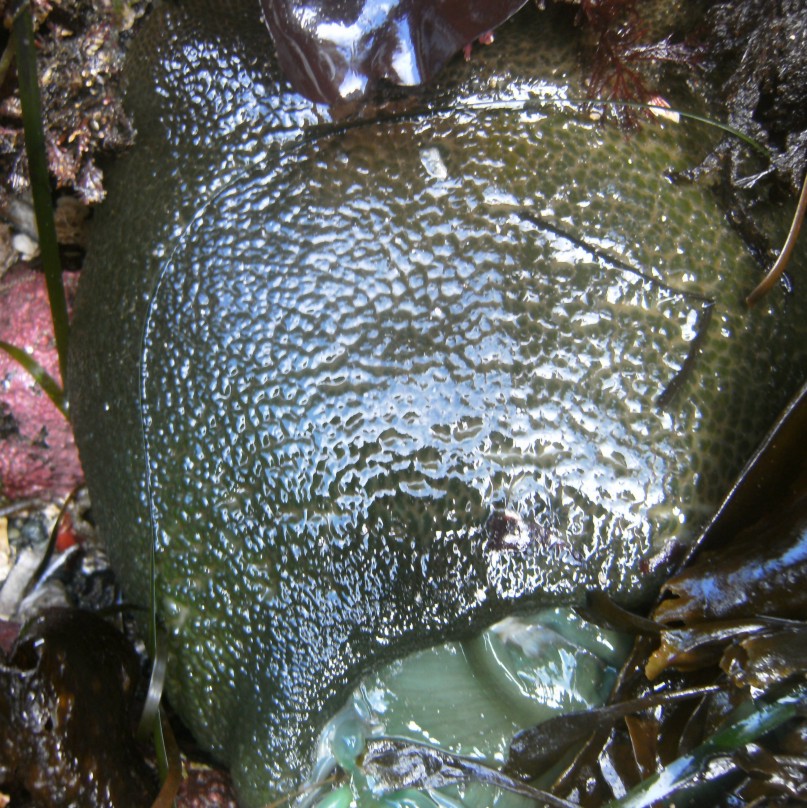
The verrucae
on the sides of the column are scattered rather than in vertical
rows.
Many of the verrucae
are compound (have several tips rather than one simple tip).
Only
a few of the verrucae
are attached to bits of shell here. Note also that the column
base
does not expand very much beyond the rest of the column.
Photo by Dave Cowles, July 2010

Usually A.
xanthogrammica
keeps its lips tightly closed. Sometimes, however, the lips
are
allowed to bulge out in frilly curtainlike folds as seen here.
Photo by Dave Cowles at Seal Beach, OR Sept 2010.
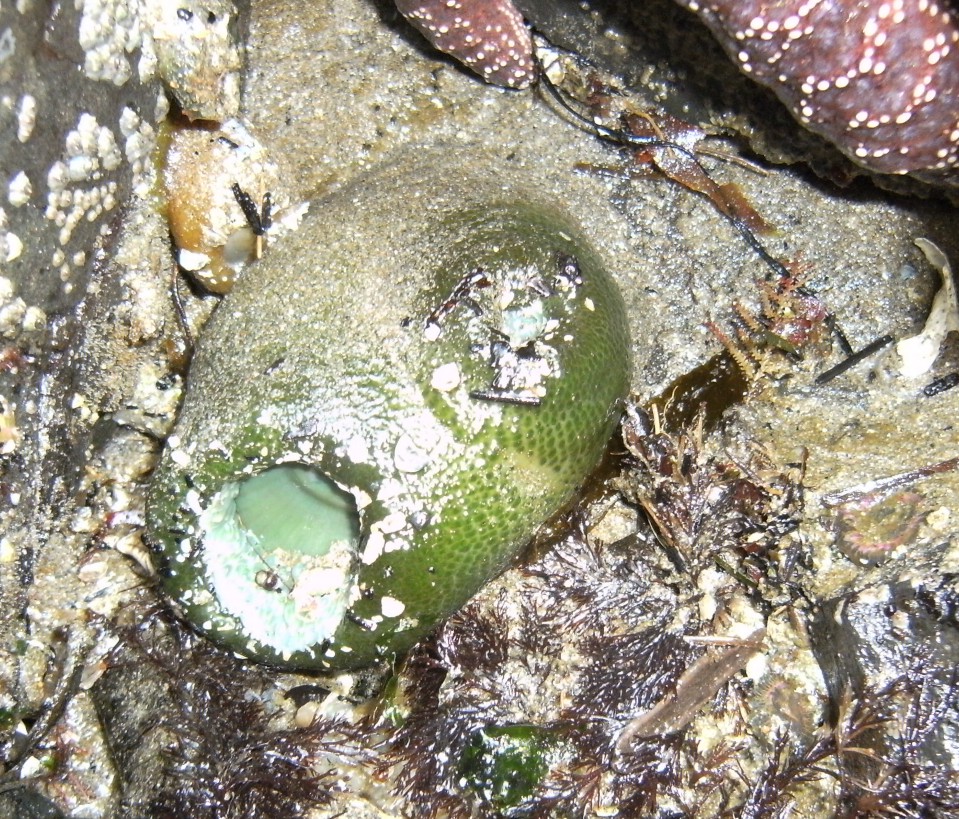
This bizarre individual, photographed by Dave Cowles in the intertidal at Seal Beach, OR September 2010, appears to have two separate oral disks. It is all the same individual and a solid bridge of tissue exists between the two oral disks.
This individual in a bedrock tidepool at Beach #4 is in a pleasing heart shape. Photo by Dave Cowles, July 2012
Authors and Editors of Page:
Brandon White created origional page 7-2002
Edited by Hans Helmstetler 12-2002
Edited by Dave Cowles 2004-
